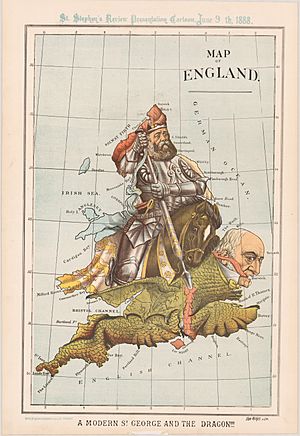Government of Ireland Bill 1886 facts for kids
| Name and origin | |
|---|---|
| Official name of legislation | Government of Ireland Bill 1886 |
| Location | Ireland |
| Year | 1886 |
| Government introduced | Gladstone (Liberal) |
| Parliamentary passage | |
| House of Commons passed? | No |
| House of Lords passed? | Not applicable |
| Royal Assent? | Not Applicable |
| Defeated | |
| Which House | House of Commons |
| Which stage | 2nd stage |
| Final vote | Aye: 311; No 341 |
| Date | 8 June 1886 |
| Details of legislation | |
| Legislature type | unicameral |
| Unicameral subdivision | 2 Orders |
| Name(s) | not given |
| Size(s) | 1st Order – 100 (25 peers, 75 elected) 2nd Order 204–206 members |
| MPs in Westminster | none |
| Executive head | Lord Lieutenant |
| Executive body | none |
| Prime Minister in text | none |
| Responsible executive | no |
| Enactment | |
| Act implemented | not applicable |
| Succeeded by | Irish Government Bill 1893 |
The Government of Ireland Bill 1886, also known as the First Home Rule Bill, was an important attempt by the British government to give home rule to Ireland. Home rule meant that Ireland would get its own government to make some laws, instead of everything being decided in Britain.
This bill was introduced on 8 April 1886 by William Gladstone, who was the Prime Minister and leader of the Liberal Party. He wanted to create a special assembly for Ireland. This assembly would handle certain areas of Irish government. The Irish Parliamentary Party, led by Charles Stewart Parnell, had been asking for home rule for Ireland since the 1870s.
Gladstone worked on this bill mostly by himself. He did not involve many Irish politicians or even his own government ministers in writing it. The bill was also meant to be introduced with another law to help farmers, but that second law was later dropped.
Contents
What the Bill Proposed
The 1886 Home Rule Bill had several main ideas:
Making Laws
- There would be a single assembly for Ireland. It was not called a "parliament" to avoid sounding too much like the old Parliament of Ireland, which had been closed in 1800.
- This assembly would have two groups, called Orders, which could meet together or separately.
- The first Order would have 28 Irish representative peers (nobles who usually sat in the House of Lords in Britain). It would also have 75 members chosen by a small group of voters. This group could delay new laws for up to three years.
- The second Order would have about 204 to 206 members. It was not fully decided if two members would be elected by university graduates, like in Dublin University.
- All Irish politicians would no longer be part of the British Parliament in Westminster.
Running the Government
- The main power would be held by the Lord Lieutenant of Ireland. This person's team would not have to answer to either of the two Orders in the new Irish assembly.
Powers Britain Kept
- Britain would still control many important things. These included peace, war, defence, treaties with other countries, trade, and coinage.
- The bill did not make any special plans for Ulster, a part of Ireland where many people wanted to stay fully linked to Britain.
- Britain would keep control of the Royal Irish Constabulary (the police force) until it felt it was safe for Ireland to take over. However, the Dublin Metropolitan Police (the police in Dublin) would come under Irish control right away.
How People Reacted
When the bill was introduced, Charles Stewart Parnell had mixed feelings. He said it had big problems but was still ready to vote for it. Prime Minister Gladstone gave a famous speech, asking Parliament to pass the bill. He said it was important to grant Home Rule to Ireland with honor, rather than being forced to do it later in shame.
However, many people in Ireland who wanted to stay part of Britain, called Unionists, and the Orange Order strongly opposed the bill. They believed Home Rule would mean "Rome Rule," meaning the Catholic Church would have too much power. In Portadown, a town known for its strong Unionist views, people celebrated the bill's defeat by attacking a Catholic neighborhood. This event was called "Storming the Tunnel" in the local newspaper.
The vote on the bill happened after two months of debate. On 8 June 1886, the bill was defeated. 341 politicians voted against it, including 93 Liberals from Gladstone's own party. 311 voted for it. Because the bill failed, Parliament was closed down on 26 June, and a new election was called.
A new political group, the Liberal Unionist Party, was formed to fight in the election. They won 77 seats and joined with the Conservatives to form a government. They continued to work with the Conservatives in future elections until the parties officially joined together in 1912.
Some historians believe the 1886 Home Rule Bill had problems because of how secretly it was written. Gladstone upset some important Liberal figures, like Joseph Chamberlain, who even quit the government because of it. Also, many Irish politicians privately thought the bill was poorly written and had serious flaws.
See also
- 1886 Belfast riots
- Government of Ireland Bill 1893 (Second Irish Home Rule Bill)
- Government of Ireland Act 1914 (Third Irish Home Rule Bill)
- Government of Ireland Act 1920 (Fourth Irish Home Rule Bill)
- History of Ireland (1801–1923)


